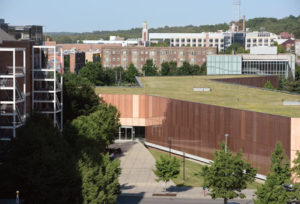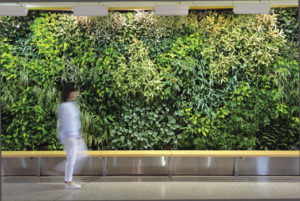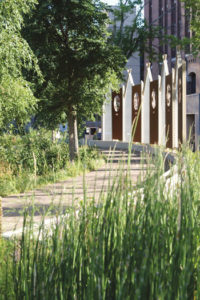Above: The concept for the downtown library included a rooftop lawn. Practicalities led away from grass to the hardy sedum plant.
Writer: Elvin McDonald
Photographer: Duane Tinkey
Now that Des Moines’ Central Library has celebrated its 11th birthday, it’s high time we checked in on the green roof. When architect David Chipperfield’s design was revealed, the green roof was met with more skepticism than might have been expected—a few people wondered if the library was hoping to grow rooftop corn and soybeans as cash crops.
The fact that Chipperfield is English also may have contributed to some of the resistance, as though he were bringing something newfangled from the old country. But green roofs have been successfully installed in Germany for at least 30 years and have spread to the United States over the past few decades; one of my friends says he saw goats eating on a green roof in Door County, Wisconsin, years ago.

In Des Moines, the library’s green roof stemmed from concerns about the potential unsightliness of the building’s mechanical systems. “David [Chipperfield] and I were presenting the project to a business community atop 801 Grand,” recalls Kay Runge, then director of Des Moines Public Library. “One person asked if they would have to look at all the mechanicals on the roof since the building would be only 29 feet tall.
“Without missing a beat, David said, ‘It will have a grass roof.’ So we planted sedum [a hardy plant] that would grow only to 11 inches tall.” And those unsightly mechanicals? They’re in the basement.
Grass wasn’t planted, but today, the vegetation on the roof “multiplies the energy efficiency of the building,” says Greg Heid, director of Des Moines Public Library. It provides natural insulation, controls water runoff and minimizes roof damage by moderating fluctuations in temperature, he explains.
The botanical roof was never intended for public enjoyment; it’s accessible only to maintenance teams managed by Heid and Ben Page, director of the Des Moines Parks and Recreation Department.
The roof’s maintenance involves two workers climbing through a scuttle and up a ladder to a rooftop hatch. They spend a couple of hours on the roof once every three weeks, Page says, adding that they use a pre-emergent herbicide, cut weeds with a string trimmer, fertilize once a year and reseed “as often as the budget allows. … We have no funds directly allocated for this.” Instead, the maintenance gets rolled into a list of details the department manages downtown, he says.
But now you really want to see the roof, don’t you? Here’s the best view: Go to the fourth floor of the nearby Temple for Performing Arts and step out onto the balcony.
Or you could just change jobs to get a daily view: “We welcome the many office workers in surrounding high-rise office buildings to enjoy the natural respite provided by its green, parklike vista,” Heid says.
The Botanical Garden’s Living Wall

Gardeners have always covered walls with greenery, but the idea has taken on new life since Patrick Blanc’s vertical garden in Paris transformed the street on which it lives and became a popular attraction.
In Des Moines, architect Mike Simonson recalls that during a planning session to turn the former Botanical Center into the Greater Des Moines Botanical Garden, community leader Tom Urban asked about incorporating a living wall. “I knew instantly that could be the answer for making the entry area more welcoming,” Simonson says.
As luck would have it, a former resident of Des Moines—Hal Thorne, CEO and chairman of Vancouver-based GSky Plant Systems Inc.—was soon engaged to install the equipment that makes the living wall possible—mostly cups for the plants and irrigation tubing.
“The planting thrives on little care,” says Botanical Garden horticulturist Tyler Johnson. “It typically includes spider plants, calatheas, pothos, peperomias, ferns and lately the ever-blooming kohlerias.”
St. Paul’s Rain Garden and Labyrinth

A garden and labyrinth anyone can visit anytime, day or night, is on the north side of the Cathedral Church of St. Paul, 801 Grand’s neighbor to the north. There you’ll find an updated revenue-producing parking area with pervious paving surrounded by a rain garden of native plants and a labyrinth that guides a contemplative walk. The garden was designed by landscape architect Doug Adamson of RDG Planning & Design.
A rain garden is a shallow basin in the ground that captures and absorbs rain from roofs, driveways or parking lots. Rain gardens rely on soils with good percolation rates to help manage heavy rains and plants that readily absorb water. Pervious paving allows water to infiltrate into layers of limestone and then into the soil and groundwater below. The process reduces the amount of water and pollution flowing into storm sewers and out to rivers.
Funding for the project came from members and friends of the church, with the help of a $100,000 grant from the Iowa Department of Natural Resources that specifically recognizes the benefits of storm-water management and the use of native plants.
The project was shepherded by the Rev. Cathleen Bascom during her time as the Cathedral’s dean. Bascom grew up in the High Plains, aware of the remnant tall-grass prairie of the Kansas Flint Hills and the Denver Water Department’s Xeriscape movement, the concept of landscaping with plants that do not require irrigation.
Today, St. Paul’s rain garden is maintained by volunteers who call themselves “Weekly Weeders.” If you’d like to participate, visit the church’s website, cathedralchurchofstpaul.org.











